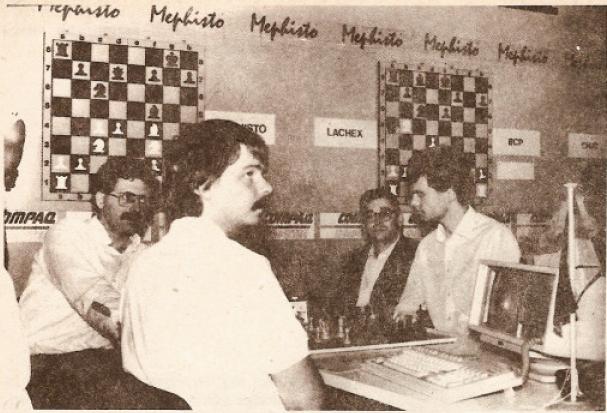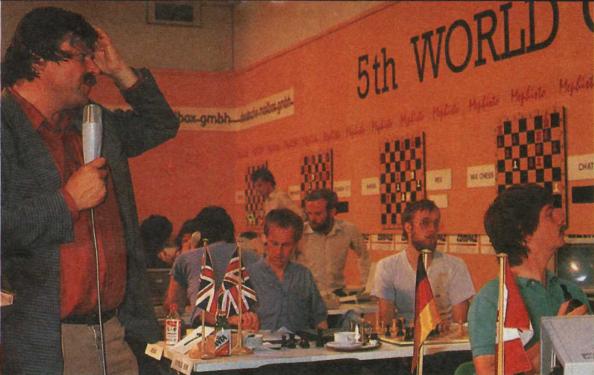Bobby
Bobby,
a chess program by Hans-Joachim Kraas and Günther Schrüfer, competing at various World Computer- and World Microcomputer Chess Championships from 1983 until 1995 [2] . Bobby had a strong WCCC 1986 in Cologne, Germany, defeating the later Champion Cray Blitz in round two, with some chances to tie first place until the last round loss against Schaeffer's Sun Phoenix [3] . In 1993, Bobby II won the 3rd International Paderborn Computer Chess Championship.
The development of Bobby started in 1982 as part of Kraas' and Schrüfer's MSc thesis. It was written entirely in Pascal on the IBM 4341-2 [4] of the TU Braunschweig. In 1987 Bobby II was a complete redesign in C on a Atari ST microcomputer. A commercial successor of Bobby II is the program Doctor?, market by ChessBase as 16-bit engine in 1995 as analysis engine for ChessBase/Windows 1.0, and in 1998 as 32-bit add-on engine of the Fritz 5.32 package [5] [6]. According to Das große Computerschachbuch. [7] , Bobby had a sophisticated evaluation, with respect to king safety and passed pawns. Bobby's search was a STC-Search (solution tree cost oriented search) [8] , as elaborated in Schrüfer's 1988 PhD thesis [9]
Contents
Photos & Games
Mephisto
Günther Schrüfer, Hans-Joachim Kraas, Ossi Weiner and Richard Lang [10], WCCC 1986, round 4, vs. Mephisto X [11]
[Event "WCCC 1986"] [Site "Cologne, Germany"] [Date "1986.06.14"] [Round "4"] [White "Bobby"] [Black "Mephisto X"] [Result "1-0"] 1.e4 Nf6 2.e5 Nd5 3.d4 d6 4.c4 Nb6 5.exd6 exd6 6.Nc3 Be7 7.h3 O-O 8.Nf3 Nc6 9.Be2 Bf5 10.O-O Qd7 11.Bf4 Rae8 12.a4 Bf6 13.a5 Nc8 14.a6 b6 15.g4 Bxg4 16.hxg4 Qxg4+ 17.Bg3 Nxd4 18.Nxd4 Qxd4 19.Qc2 h6 20.Rfd1 Qc5 21.Nb5 Be5 22.Rd5 Qc6 23.Bxe5 Rxe5 24.Rxe5 dxe5 25.Bg4 Nd6 26.Nxa7 Qc5 27.Bd7 e4 28.Nb5 Nxb5 29.Bxb5 Qg5+ 30.Kf1 Qh4 31.Rd1 Qh1+ 32.Ke2 Qf3+ 33.Ke1 Qh1+ 34.Kd2 Qg2 35.Kc1 Qg6 36.Qb3 c6 37.Ba4 c5 38.Qg3 Ra8 39.Qxg6 fxg6 40.Bb5 g5 41.Rd7 h5 42.a7 e3 43.fxe3 Rf8 44.Bc6 h4 45.a8=Q Rxa8 46.Bxa8 h3 47.Rd5 1-0
Sun Phoenix
WCCC 1986, round 5, Vlastimil Hort, Frans Morsch, Hans van der Zijden, Hans-Joachim Kraas [12], Bobby vs. Sun Phoenix
[Event "WCCC 1986"] [Site "Cologne, Germany"] [Date "1986.06.15"] [Round "5"] [White "Bobby"] [Black "Sun Phoenix"] [Result "0-1"] 1.e4 e6 2.b3 d5 3.Bb2 dxe4 4.Nc3 Nf6 5.Qe2 Be7 6.O-O-O Qd4 7.Re1 O-O 8.Nxe4 Qxe4 9.Qxe4 Nxe4 10.Rxe4 Nd7 11.Nf3 Bc5 12.d4 Nf6 13.Rh4 Be7 14.Kb1 e5 15.h3 e4 16.Ne5 Be6 17.Bc4 Bxc4 18.bxc4 c5 19.d5 e3 20.Rf4 exf2 21.Rxf2 Ne4 22.Rf4 Nd2+ 23.Ka1 Bd6 24.Re1 Rae8 25.Re2 f5 26.Rh4 Ne4 27.Nd3 Re7 28.Re3 g6 29.Nc1 Rfe8 30.a4 h5 31.Nb3 Kh7 32.Na5 Kh6 33.Rf3 Ng3 34.Rb3 b6 35.Nc6 Re1+ 36.Ka2 g5 37.Nxa7 Ra8 38.Nb5 Rxa4+ 39.Ba3 Be5 40.Nd4 0-1
Strategic Quiescence Search
Bobby applied a so called Strategic Quiescence Search as described in a 1989 ICCA Journal paper by Günther Schrüfer [13]. Schrüfer claimed the inclusion of certain none tactical moves in quiescence search an improvement over a pure tactical search in Bobby. He also stated, for some programs it might be a significant speed penalty in the number of moves searched per second to do so, i.e. in generating quiet moves. In Bobby this was irrelevant, since many of the values required have been precomputed for each node in any case. Beside the standard standing pat forward pruning conditions FP1 and FP2, all successors, not only captures, promotions and checks, were tested versus the forward pruning condition FP3.
Pseudo Code
int StategicQS(CNode n, int α, int ß) {
int bestval = eval(n);
if ( bestval >= ß ) return bestval; // FP1, fail soft
if ( bestval > α ) α = bestval; // FP2
for all n´€ SUCC(n) do { // search loop
if ( evalPlus(n´) > α ) { // FP3
int actval = -StategicQS(n´, -ß, -α);
if ( actval > bestval ) {
bestval = actval;
if ( bestval >= ß ) return bestval;
if ( bestval > α ) α = bestval;
}
}
else if ( evalPlus(n´) > bestval ) bestval = evalPlus(n´);
}
return bestval;
}
Eval+
The evalPlus value is +oo in case of checking moves near the horizon, but scaled to zero for deeper searches to avoid "infinite" checks and search explosion. Otherwise evalPlus is incrementally calculated by eval(n) and move properties. In case of tactical moves, the sum of eval(n) and the value of a captured and/or promoted piece and a constant representing half the value of a Pawn is taken. For quiet or strategical moves, evalPlus relies on maximum score differences of two consecutive evaluations n´ and n, triggered by history success counters:
if ( isCheck ) return infiniteIfNearBelowHorizon(depth); if ( isCapture && isPromotion ) return eval(n) - VALUE_PAWN/2 + Value(captured piece) + Value(promoted piece); if ( isCapture ) return eval(n) + VALUE_PAWN/2 + Value(captured piece); if ( isPromotion ) return eval(n) - VALUE_PAWN/2 + Value(promoted piece); return eval(n) + hist[from][to].diff;
History Update
Positive history based success counters are associated with the maximum difference of two consecutive evaluations n´ and n found so far, while zero saturated counters also have zero difference and are therefor always pruned by FP3. Following scheme is used to update the butterfly boards:
for all n´€ SUCC(n) do {
int actval = -search(n´, -ß, -α);
...
if ( none tactical ) {
// History update by quiet move n -> n´
if ( eval(n´) > eval(n) && actval > eval(n) ) {
hist[from][to].success += 10;
if ( eval(n´) - eval(n) > hist[from][to].diff )
hist[from][to].diff = eval(n´) - eval(n);
}
else if ( entry.success > 0 ) {
hist[from][to].success--;
if ( hist[from][to].success == 0 ) hist[from][to].diff = 0;
}
}
...
}
See also
Publications
- Rainer Bartel, Hans-Joachim Kraas, Günther Schrüfer (1985). Das große Computerschachbuch. Data Becker, Düsseldorf, ISBN 3-89011-117-3 (German), from amazon.de
- Günther Schrüfer (1988). Minimax-Suchen : Kosten, Qualität und Algorithmen. Braunschweig : Technische Universität. (German)
- Günther Schrüfer (1989). A Strategic Quiescence Search. ICCA Journal, Vol. 12, No. 1
External Links
Chess Program
Misc
References
- ↑ Bobby Fischer at the 14th Chess Olympiad, Leipzig, 1960, during the game versus Mikhail Tal, Bundesarchiv Bild 183-76052-0335, Schacholympiade, Tal (UdSSR) gegen Fischer (USA) by Ulrich Kohls, On Oct. 28, 1960 the final round began. Shown here: USSR - USA: World Champion Tal - Fischer International Grandmaster - "The clash of two top stars was short but pithy game" resulting in a draw. This is game 23 in Fischer's My 60 Memorable Games. Tal is in the act of playing 7 ... Ne7, see also Fischer vs Tal (Leipzig ol 1960) - Chess.com
- ↑ Bobby's ICGA Tournaments
- ↑ Helmut Horacek, (1986). The Fifth World Computer Chess Championship Cologne, 1986, Research Unit for Information Science and Artificial Intelligence, University of Hamburg, from Kings move Welcome to the 1989 AGT World Computer Chess Championship. pg 21, available as pdf reprint from The Computer History Museum
- ↑ IBM Reference / Glossary
- ↑ Fritz 5.32 - mehr als nur ein Update! by Peter Schreiner (German), Schachclub Leinzell
- ↑ Doctor? 2.0 / Engine MacIntosh from Schachversand Niggemann
- ↑ Rainer Bartel, Hans-Joachim Kraas, Günther Schrüfer (1985). Das große Computerschachbuch. Data Becker, Düsseldorf, ISBN 3-89011-117-3 (German), from amazon.de
- ↑ Doctor? by Dr. Hans-Joachim Kraas and Dr. Gunther Schrüfer
- ↑ Günther Schrüfer (1988). Minimax-Suchen : Kosten, Qualität und Algorithmen. Braunschweig : Technische Universität. (German)
- ↑ László Lindner, A SZÁMÍTÓGÉPES SAKK KÉPEKBEN című melléklete - The pictures of the Beginning of Chess Computers
- ↑ Cologne 1986, Chess, Round 4, Game 4
- ↑ Image from Pierre Nolot (1986). Echecs: Les Progès des Programmes. Jeux et Stratégie
- ↑ Günther Schrüfer (1989). A Strategic Quiescence Search. ICCA Journal, Vol. 12, No. 1


